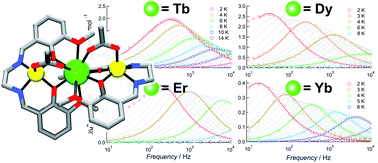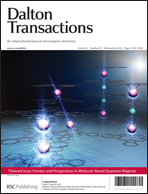Six linear trinuclear [Ln{Zn(L)(AcO)}2]BPh4 complexes (H2L denotes the Schiff-base ligand formed by a condensation reaction between ethylenediamine and two equivalents of o-vanillin), including Ln = Tb (1), Dy (2), Ho (3), Er (4), Tm (5) and Yb (6) were synthesized and were confirmed to be isostructural via X-ray crystallographic analyses. The Ln(III) ion in each complex is deca-coordinated by four equatorial oxygen donors from the methoxo groups of the Schiff-base ligands, two oxygen donors from the acetate anions and four axial oxygen donors from the phenoxo groups of the Schiff-base ligands. AC susceptibility measurements, with an oscillating frequency of 10 to 10 000 Hz, revealed that 1, 2, 4 and 6 show slow magnetic relaxation under a 1000 Oe DC bias field, which occurs via a single process, as confirmed by the semi-circular Cole–Cole plots. These complexes are considered to be field-induced single-molecule magnets under these conditions. The presence or absence of the slow magnetic relaxation process is discussed by correlating the characteristic magnetic anisotropy of each Ln(III) ion with the ligand field anisotropy.

You have access to this article
 Please wait while we load your content...
Something went wrong. Try again?
Please wait while we load your content...
Something went wrong. Try again?


 Please wait while we load your content...
Please wait while we load your content...